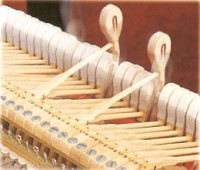Why Humidity Control Is Important for Pianos
Proper humidity control prevents:
- Costly, Permanent Bridge and Soundboard Damage
- Pinblock Damage
- Serious Rust Damage to Strings and Pins
- Sticking Keys
- Sluggish, Unresponsive Keyboard Action
(Click one of the links to skip to the section below)
To protect your instrument, I highly recommend the specially designed climate control system for the inside of your piano. This product, made by Dampp-Chaser Corporation, is both a humidifier and dehumidifier that alternates automatically to keep the humidity at 45% throughout the year. This unit is silent, hidden, easy to care for, and works better than anything else available. It’s been around for decades, and continues to prove its effectiveness in the hundreds of installations I’ve done over the years.
The climate control system is endorsed by piano manufacturers, the Piano Technicians Guild, and many experienced technicians throughout the country. This product is the most effective way to care for your piano while saving yourself hundreds of dollars in unnecessary repair and maintenance costs. This climate control system will also allow your instrument to give you its best in performance and sound for many years to come. For any additional questions, or to schedule an installation, contact me now.
Prevent Costly, Permanent Bridge and Soundboard Damage
The soundboard is the single largest piece of wood in your piano. It actually vibrates to amplify the sound produced by the strings. The bridges of your piano are joined to the soundboard and support the strings.
As the soundboard absorbs moisture from the air surrounding the piano, it swells, producing an upward bulge. Through the bridge, this puts additional tension on the strings. Now, the pitch is too high in the lower mid-range and treble section.
When the soundboard shrinks and flattens in dry air, the tension of strings over the bridge becomes inadequate. The pitch of the mid-range and treble section is now flat.
Over time, constant changes in humidity levels, with the corresponding shrinking and swelling of the soundboard, will damage the integrity of the soundboard. You will see this damage in the form of a crack in the soundboard.

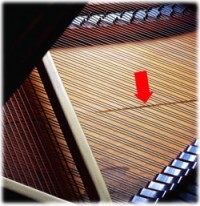
Prevent Pinblock Damage
The strings of your piano are held tight by the pins in the pinblock. As the pinblock absorbs moisture in periods of high humidity, it swells, crushing the wood fibers against the pin.
In dry periods, the wood shrinks away from the pin, loosening it and causing the string to sag. When this cycle is repeated time after time, the wood fibers surrounding the pin are destroyed and lose their resilience.
In this picture, the pinblock (without pins) was removed from a piano during restoration. With continuous swelling and shrinking, the wood could no longer provide the snug fit required to hold pins in place.
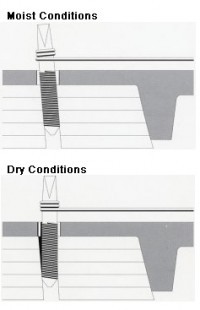

Prevent Serious Rust Damage to Strings and Pins
The strings of your piano are responsible for producing the musical sounds. With exposure to high humidity levels over long periods, strings become rusted and corroded.
At the junction where rusted strings wrap around rusted pins, rust corrosion forms a hardened bond between the two. Then, during a tuning, when your piano technician turns the pins to stretch the strings, the inflexible, rusted string snaps at this joint.
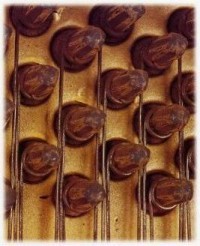
Prevent Sticking Keys
Just as doors and drawers become tight and difficult to move, the keys of your piano may stick down when struck in times of high humidity. In too-dry conditions, the keys may seem to rattle or exhibit clacking, noisy action when played.
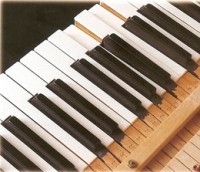
Prevent Sluggish, Unresponsive Keyboard Action
As you play your piano, you will notice how responsive the keys are to your touch. The way the keys cause the hammers to strike the piano strings is part of thousands of interconnected wooden parts called the piano action. With high moisture levels in the piano action, the action is sluggish, and the keys seem non-responsive to your touch.
